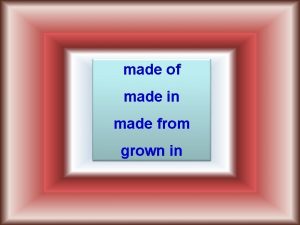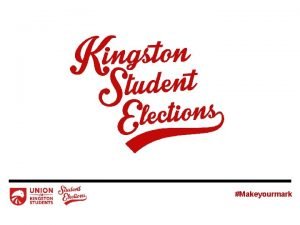Congratulations You made it this far Welcome to






























- Slides: 30

Congratulations! You made it this far! Welcome to 2 nd Semester AP World History

What’s in store for this semester? Unit I: 1450 - 1750 Ü Changes in trade, technology, and global interactions Ü Major Empires, political units and social systems Ü (Ottoman, China, Portugal, Spain, Russia. . . , Tokugawa, Mughal, Songhay. . . ) Ü Slave trade Ü Changes and Continuity in Confucianism

Unit II: 1750 -1914 Ü Changes in global commerce, communications, and technology (world trade, Industrial Revolution) Ü Demographic and environmental changes (migrations, end of Atlantic slave trade, new birthrate patterns, food supply) Ü Changes in social and gender structure (Industrial Revolution, emancipation of serfs/slaves) Ü Political revolutions and independence movements (Latin American Independence, revolutions, nationalism/nation-states, political reform, rise of democracy and limitations: reform, women, racism) Ü Rise of Western dominance and reactions (economic, political, social, cultural, artistic, imperialism)

Unit III: 1914 -1990 Ü World Wars, Holocaust, Cold War, nuclear weaponry, international organizations, global balance of power (reduction of European influence, League of Nations, United Nations, Non-Aligned Nations) Ü New patterns of nationalism (interwar years, decolonization, racism, genocide, breakup of the USSR) Ü Global economic developments (Great Depression, Pacific Rim, multinational corporations) Ü Social reform and social revolution (changing gender roles, family structures, rise of feminism, peasant protest, international Marxism) Ü Globalization (science, technology, culture) Ü Demographic and environmental changes (migrations, birth/death rates, urbanization, deforestation, green/environmental movements)

Important Dates… Ü Thursday, May 17 th – AP Exam


Review of Regions…

Slavery – Why do Africans become the main group? Ü It has been debated why Africans become the main source for slavery beginning in the late 1400 s. Ü There are several factors. One, the Christian bishops/Pope decided that Christians should not be slaves! Ü This was not a popular move by all Christian parents. In the Ottoman Empire, poor parents frequently sold their children to be slaves. There was an elite army created known as the janissaries made up in large part of Christian children. They were forced to convert to Islam but the parents reaped financial rewards for this!

Ü Two, is related to African agriculture and economics. Ü Partly because of the tsetse fly causing diseases and poor soils, farmers had great difficulty using draft animals so most work was done by hand with a hoe, causing low productivity. Ü Economists reason that in most societies the value of a worker’s productivity determines the value of their labor so in Africa, the economic value of an African to their society was lower than the economic value of a European peasant in Europe. Ü Slaves in the Americas were more productive than free producers in Africa and European slave dealers were willing to pay a higher price than the value of an African’s productivity in Africa.

Ü A third factor is disease. Ü Smallpox had wiped out large numbers of Native Americans through contact and enslavement. Ü Between 30 and 50 percent of Europeans died of malaria when exposed. Ü But Africans had developed some immunity to both diseases and therefore had the lowest mortality rate of any people in the Americas.

Outcome Ü Slavery became about RACE for the first time in history! Ü In part this was because Africa was not Christian at this time. The north was Islamic and sub-Saharan was mainly practicing polytheistic tribal religions (Christianity begins here mainly in the late 1700 s).

Methods of exchanging goods for slaves Ü Factory-forts – served as markets, warehouses, customs, defense and support for navigation or exploration Ü Shore method – European ships sent boats ashore or invited African dealers to bring traders and slaves out to the ships. Ü This method allowed the ships to move easily from market to market

Significance of Angola Ü Angola produced 26 percent of all African slaves and 70 percent of all Portuguese slaves, which makes sense when you consider that straight west is Brazil. Ü The two significant cities for Angola were Luanda and Benguela. 8, 000 -10, 000 slaves left each year from Luanda and from Benguela.

Monopoly of the Slave Trade Ü Portugal monopolized the slave trade until 1600. Ü From 1690 until 1807, England was the leading carrier of slaves.

Other Slave Trade Reminders: Ü Use of Slave Trade in Europe and Why? Ü First slaves to Portugal Ü Approximate number of slaves that went to the Americas between 1450 and 1850 Ü Mortality rate of trans-Atlantic journey and rates from capture to coast in Africa Ü Along with numbers to the Americas, 6 million were exported to Asia and 8 million slaves were retained in Africa Ü Why was the high volume of slave trade more necessary in the Caribbean and Latin America than in the southern US?

Impact Ü American markets wanted young male slaves. Ü The Asian and African markets preferred young females. Women were sought as concubines and because they were less likely to rebel than young men. Ü Consequently, two-thirds of those exported to the Americas were male, one-third female. Ü The population on the western coast of Africa became predominantly female; in the east African Savanna and the Horn regions the population was predominantly male. Ü The slave trade therefore had significant consequences for the institutions of marriage, slavery itself, and the sexual division of labor.

Olaudah Equiano Reading 1. On the basis of Equiano’s account, describe the role of Africans in the slave trade. 2. What does Equiano’s account reveal about the effect of slaving on African society? 3. What were the characteristics of slavery that Equiano encountered? 4. Once aboard the slave ship, what fears did young Olaudah Equiano experience? 5. What in the slaves’ experiences contributed to their despair and demoralization according to Equiano? 6. How did the black slavers in Africa compare to the Europeans in Equiano’s perception? 7. Why did Equiano address his readers as “nominal Christians”? 8. Are there any pieces here that challenge your previous understanding of the slave trade?

Plantation Systems

I. Sugar and Slaves (Trans. Atlantic Trade) Ü A. In 1640 the English colony of Barbados depended largely on tobacco grown by free and indentured European settlers. Ü B. By the 1680 s sugar was the principal crop and enslaved Africans were 3 x more numerous than Europeans. Ü C. During the first half of the 1600 s, most slaves went to Brazil, which was the world’s principal source of sugar. Ü D. By 1700, the West Indies had surpassed Brazil in sugar production and over half of the slaves went to the English, French, and Dutch West Indies. Ü E. In the 1670 s the French seized the western half of the Spanish island of Hispaniola. During the 1700 s Saint Domingue (Haiti today) became the greatest producer of sugar in the Atlantic world. **


II. Sugar Production Ü A. Canes are ready for harvesting within 14 -18 mos. Ü B. Simple tools: spades, hoes, machetes Ü C. Factories as well as Farms Ü 1. had to crush the canes w/in hours to extract the sugary sap (crushing was done in a mill, windmills or water-powered, or by hand) Ü 2. wooden troughs carried cane juice to copper kettles, water gets boiled away leaving thick syrup Ü 3. syrup is put into molds, dried into sugar crystals, shipped in wooden barrels to Europe Ü 4. dark molasses made into rum or barreled for export Ü D. Jamaica specialized so heavily in sugar production, it had to import most of its food

III. Columbian Exchange Ü A. Spanish brought cattle, pigs, horses until 1503 and then new imports weren’t necessary. Also - bananas, plantains Ü B. from Africa, along with slaves came okra, black- eyed peas, yams, millet, sorghum, mangoes

IV. Repopulation Ü A. During the first 50 yrs. of Columbus’ first voyage, whole indigenous tribes were eliminated Ü B. Islands were repopulated first from Europe and then from Africa Ü C. 90% of the population on most islands were slaves

V. Gender Distribution Ü A. twice as many male slaves as females came to the West Indies Ü B. more female slaves than males came to (Southeast Asia) Ü C. females, as well as males, came to southern plantations of the U. S. , families were encouraged Ü D. life expectancy for slaves in 19 th Century Brazil: 23 yrs. of males, 25. 5 years for females

VI. Language Ü A. Slaves were frequently forced to learn colonial languages and discouraged to speak African languages by deliberately mixing slaves from different parts of Africa. Ü B. Creole did develop in some locations, mixing European and African languages.


East African Slave Trade Reading Ü Long history of East African slave trade (domestic servants, concubines, or plantation workers to Arabia and the Persian Gulf) Ü Trade increased in the late 18 th and early 19 th centuries Ü 1) French opened sugar and coffee plantations on their Indian Ocean colonies Ü 2) Brazilians were not getting enough slave labor from the west African coast Ü Shortage of slaves meant prices rose…now profitable for Brazilians to make the longer trek to the east coast Ü 3) Increase in Arab demand for slaves to work plantations on Zanzibar and surrounding islands (cloves)

East African Slave Trade Reading Continued… Ü In 1873, British persuaded sultan of Zanzibar to close the slave market. Ü European demand for ivory was increasing Ü Although fewer humans were exported from the east coast, men and women still forced to carry tusks of ivory to the coast

CCOT – Change & Continuity Over Time Ü Evaluate African Slave Trade Ü 3 -5 Changes Ü 2 -3 Continuities

 Congratulations you made it this far
Congratulations you made it this far All of their time and space are foggy slum figure of speech
All of their time and space are foggy slum figure of speech An elementary school classroom in a slum rhyme scheme
An elementary school classroom in a slum rhyme scheme In a kingdom far far away
In a kingdom far far away Far far away city
Far far away city Congratulations you are accepted
Congratulations you are accepted Congratulations you got grounded
Congratulations you got grounded I hear you've passed your exam. congratulations – ____
I hear you've passed your exam. congratulations – ____ Congratulations you have been selected
Congratulations you have been selected Congratulations grant award letter
Congratulations grant award letter Classmate compliments
Classmate compliments What is congratulation expression
What is congratulation expression Congratulations your application has been approved
Congratulations your application has been approved Congratulations to my dear students
Congratulations to my dear students Congratulations my dear students
Congratulations my dear students Congratulations on your transition
Congratulations on your transition Congratulations slide template
Congratulations slide template If i could only teach you one thing why god made you
If i could only teach you one thing why god made you If you made a formal solemn promise you
If you made a formal solemn promise you Wise men three clever are we
Wise men three clever are we How far do you agree
How far do you agree Perceptual disharmony
Perceptual disharmony How far can you reach
How far can you reach You say you love the rain but you open your umbrella
You say you love the rain but you open your umbrella Eat meals that are nutritious agree or disagree
Eat meals that are nutritious agree or disagree If you think you can you can poem
If you think you can you can poem Tell me what you eat and i shall tell you what you are
Tell me what you eat and i shall tell you what you are I will follow you follow you wherever he may go
I will follow you follow you wherever he may go Welcome we're so glad you're here
Welcome we're so glad you're here Welcome we are glad you are here
Welcome we are glad you are here Video platform
Video platform




















































